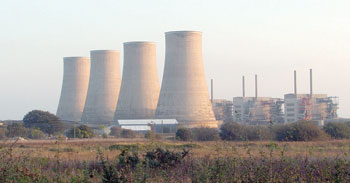We looked at how the enriched uranium is formed into pellets and how these are used in the reactor, how to control them like when an operator wants the uranium core to produce more heat, the control rods are lifted out of the uranium bundle (thus absorbing fewer neutrons).


We looked at how the enriched uranium is formed into pellets and how these are used in the reactor, how to control them like when an operator wants the uranium core to produce more heat, the control rods are lifted out of the uranium bundle (thus absorbing fewer neutrons).
To reduce heat, they are lowered into the uranium bundle. The rods can also be lowered completely into the uranium bundle to shut the reactor down in the event of an accident or to change the fuel. Since the uranium bundle acts as an extremely high-energy source of heat. It heats the water and turns it to steam.
The steam drives a turbine, which spins a generator to produce power. Humans have been harnessing the expansion of water into steam for hundreds of years.
In some nuclear power plants, the steam from the reactor goes through a secondary, intermediate heat exchanger to convert another loop of water to steam, which drives the turbine.
The advantage to this design is that the radioactive water/steam never contacts the turbine.
Also, in some reactors, the coolant fluid in contact with the reactor core is gas (carbon dioxide) or liquid metal (sodium, potassium); these types of reactors allow the core to be operated at higher temperatures.
Given all the radioactive elements inside a nuclear power plant, there is much more to it than the coal or heating oil power plants that do not need the necessary radiation safety.
Once you get past the reactor itself, there’s very little difference between a nuclear power plant and a coal-fired or oil-fired power plant, except for the source of the heat used to create steam.
But as that source can emit harmful levels of radiation, extra precautions are required. A concrete liner typically houses the reactor’s pressure vessel that acts as a radiation shield.
That liner, in turn, is housed within a much larger steel containment vessel.
This vessel contains the reactor core, as well as the equipment plant workers use to refuel and maintain the reactor.
The steel containment vessel serves as a barrier to prevent leakage of any radioactive gases or fluids from the plant.
An outer concrete building serves as the final layer, protecting the steel containment vessel. This concrete structure is designed to be strong enough to survive the kind of massive damage that might result from earthquakes or a crashing jet airliner.
These secondary containment structures are necessary to prevent the escape of radiation/radioactive steam in the event of an accident.
The secondary containment was introduces as a lesson from the absence of secondary containment structures in the Chernobyl nuclear power plants that allowed radioactive material to escape in when there was an accident.
Workers in the control room at the nuclear power plant can monitor the nuclear reactor and take action if something goes wrong. Nuclear facilities also typically feature security perimeters and added personnel to help protect sensitive materials.
In our next episode, we shall look at the pros and cons of the Nuclear Power. In this method of generating power an evil? If so, is it a necessary evil?
(To be continued)


